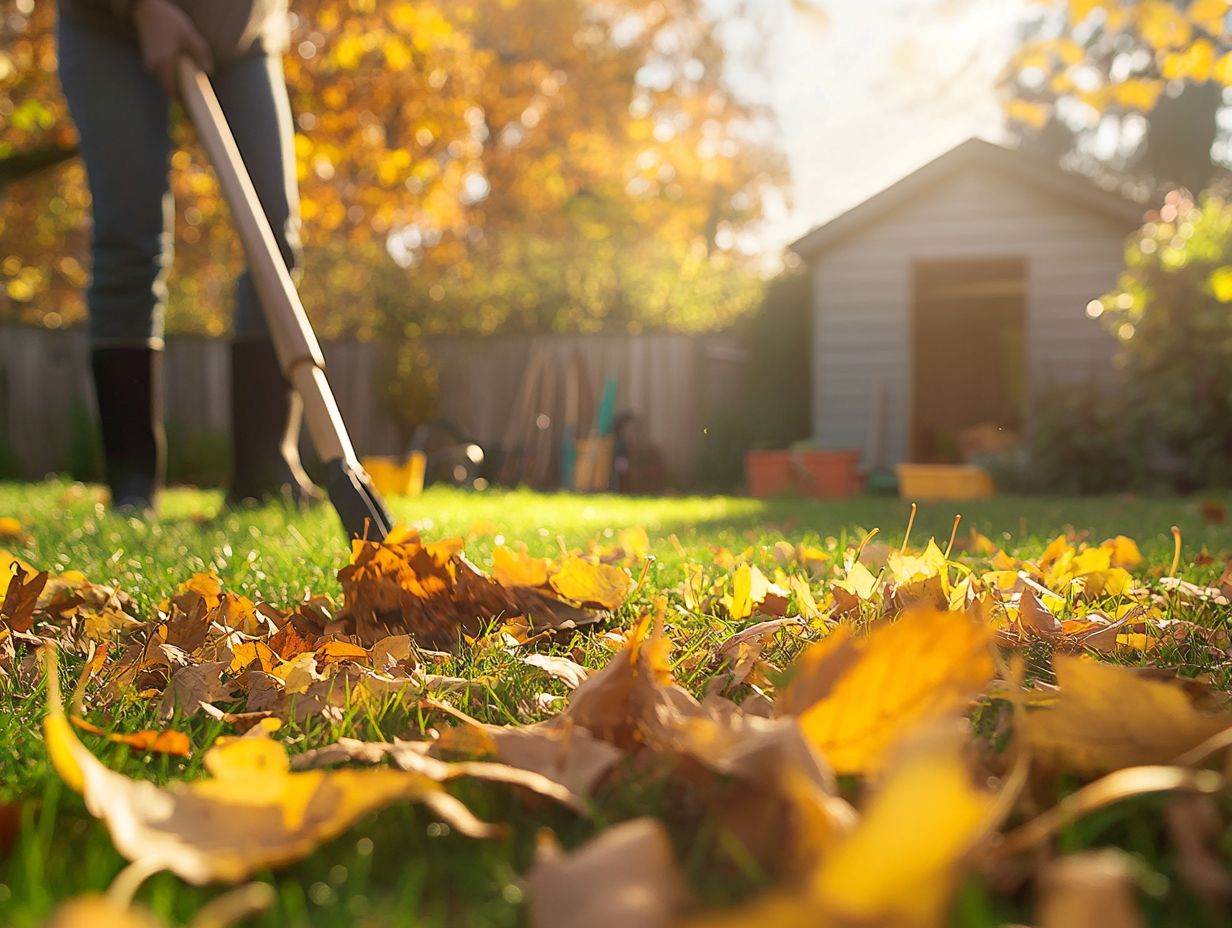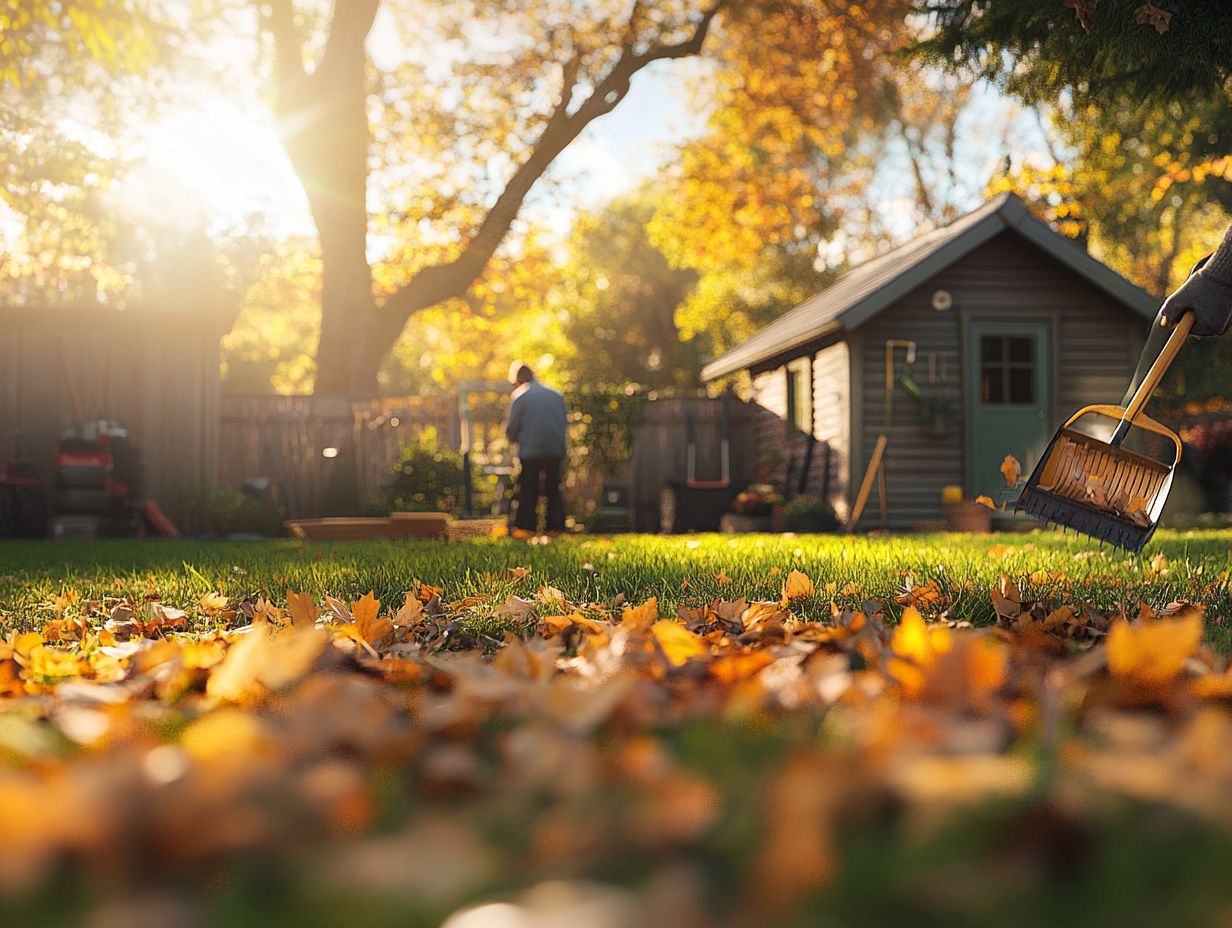As the vibrant colors of fall begin to adorn our landscapes, it is important to shift our focus to a vital aspect of home care: the lawn.
Preparing your yard for the winter months is not merely a matter of aesthetics; it is essential for the overall health and resilience of the grass.
Let’s explore some key fall lawn care tasks, including Leaf Removal, Fertilization, and Overseeding, as well as addressing common issues that may arise.
Equipped with the right tips and tools, including Lawn Equipment, you can ensure a lush, green lawn when spring arrives.
It’s time to give your lawn the attention it truly deserves.
The Importance of Fall Lawn Care

Fall lawn care plays a vital role in keeping your yard healthy and vibrant as we move into the winter months. Taking the time to prepare during this season not only encourages strong root growth but also improves the overall appearance of your lawn, making it a standout in the neighborhood.
Implementing effective maintenance practices in the fall, such as soil testing and following seasonal advice, ensures that your grass—whether it's cool-season or warm-season—is well-equipped to handle the stresses of winter. By being proactive with your lawn care routine, you can lay the groundwork for a lush, green lawn when spring arrives.
Why Preparing Your Lawn for Winter is Crucial
Preparing your lawn for winter is essential for maintaining its health and vitality during the colder months and into the spring. By focusing on key practices such as proper fertilization and overseeding, you can enhance root growth and strengthen your grass against harsh winter conditions.
This proactive approach not only contributes to a healthier lawn but also minimizes the environmental impact associated with lawn care in the spring. Neglecting winter preparation can lead to various lawn diseases and deterioration as spring arrives.
Techniques such as aerating the soil and applying an appropriate mulch layer can significantly benefit overall lawn health. Aeration allows air, water, and nutrients to penetrate deeper into the soil, fostering robust root development necessary for survival in freezing temperatures.
Additionally, applying a winterizer fertilizer rich in potassium can enhance Disease Prevention, ensuring that your grass remains resilient against pathogens.
By prioritizing these strategies, you not only cultivate a lush and vibrant lawn come spring but also support sustainable practices that reduce reliance on chemical treatments, further promoting ecological balance.
Essential Fall Lawn Care Tasks
Essential fall lawn care tasks are the foundation of effective Lawn Maintenance, helping to keep your yard Lawn Health healthy and vibrant throughout winter and into spring.
Adjusting your Mowing Techniques, maintaining a consistent Watering Schedule, and removing leaves are crucial steps for promoting robust grass growth and minimizing thatch buildup.
Proper fertilization techniques, which include achieving the right balance of nitrogen, phosphorus, and potassium, will further enhance turf health and prepare your lawn for winter challenges.
Additionally, recognizing the significance of Soil Amendments and Composting can greatly improve your lawn’s overall well-being and Lawn Fertility.
Raking and Removing Debris

Raking and removing debris is an essential aspect of fall lawn care that can greatly improve your lawn's health. By consistently clearing away leaves and other organic materials, you help prevent potential pest issues and enhance air circulation for your grass. Utilizing the appropriate lawn care products during this process is key to maintaining healthy soil and turf. If debris is left unattended, it can promote the growth of lawn diseases and undermine your lawn maintenance efforts.
A well-kept lawn not only enhances the visual appeal of your property but also supports a vibrant ecosystem. Effective debris management includes timely raking and using compost bins for organic waste, which improves soil quality.
Plus these practices, incorporating pest management strategies—such as introducing beneficial insects and applying targeted treatments—can further protect your yard from infestations. When combined with high-quality lawn care products, these strategies ensure that your grass receives the essential nutrients it needs.
By nurturing a healthy lawn environment, you significantly decrease the likelihood of Disease Prevention and Pest Management problems, resulting in a lush, resilient landscape that thrives throughout the seasons.
Fertilizing and Overseeding
Fertilizing and overseeding in the fall is crucial for enhancing the health and resilience of your lawn. By applying organic fertilizers that are rich in nitrogen, phosphorus, and potassium, you not only nourish the existing grass but also create an excellent foundation for new seeds to germinate. This practice is especially important for cool-season grasses, as fall offers the ideal conditions for seed establishment and root development. Proper fertilization during this season promotes healthy soil, ensuring that your lawn thrives when spring arrives.
As temperatures begin to cool and moisture levels rise, the fall season creates an environment that is conducive to strong root growth. By choosing high-quality organic fertilizers, one can enhance microbial activity in the soil, which significantly improves nutrient availability.
When overseeding, it is important to follow best practices, such as lightly raking the lawn before application and ensuring that the seeds make good contact with the soil for optimal germination. Regular watering after spreading the seeds is essential, as it creates the moist environment necessary for successful seedling growth and helps strengthen the lawn against potential weeds.
Aerating and Dethatching
Aerating and dethatching are essential tasks for fall lawn care that can significantly enhance turf health and address common lawn issues.
When executed properly, these procedures create an environment where grass can thrive. Aeration is especially effective in combating soil compaction, a frequent problem in many yards that restricts the absorption of vital resources. By creating small holes in the soil, aeration improves water drainage and allows beneficial microorganisms to flourish, promoting overall soil health.
On the other hand, dethatching helps remove the thick layer of dead grass and organic matter that can accumulate over time. This layer not only blocks sunlight but also retains excess moisture, which can lead to mold or pest issues.
Together, these techniques ensure that your lawn receives the nutrients necessary for robust growth and resilience.
Common Fall Lawn Problems and Solutions

Addressing common fall lawn problems is crucial for maintaining a healthy landscape and ensuring your grass thrives throughout the winter. Issues like pest infestations, lawn diseases, and invasive weeds can greatly affect the overall health of your turf.
By implementing effective pest management strategies and targeted weed control methods, you can significantly enhance the condition of your lawn. Additionally, exploring lawn restoration techniques will help rejuvenate any stressed or damaged areas, ensuring your yard looks its best when spring arrives.
Dealing with Pests and Diseases
Managing pests and diseases is a crucial part of fall lawn care that can significantly impact the health of your grass. As the seasons shift, certain pests, like grubs and chinch bugs, become more common, while conditions such as cooler temperatures and moisture can lead to diseases like brown patch and dollar spot.
It's important to recognize the early signs of these infestations, which may include wilting, discoloration, or unexpected bald patches. Timely intervention is essential to address these issues effectively.
Utilizing integrated pest management strategies, which blend cultural practices with biological controls, can help tackle these problems without heavily relying on chemicals. Additionally, partnering with lawn care services can provide customized strategies tailored to local climate conditions, ensuring that your grass remains vibrant and resilient throughout the fall season.
Addressing Bare Patches and Weeds
Addressing bare patches and weeds is a crucial aspect of fall lawn care that can greatly enhance both the aesthetics and health of your yard. Implementing overseeding techniques effectively fills in those bare areas, while consistent weed control helps prevent competition for essential nutrients and water.
Additionally, understanding common lawn care myths enables homeowners to make informed decisions about their maintenance practices, ensuring a healthy, green lawn.
Incorporating practices such as aeration, which improves soil structure, along with the application of appropriate fertilizers, creates an optimal environment for grass growth. It is also important to adopt effective weed management strategies, like applying mulch and maintaining a regular mowing schedule, to minimize the presence of unwanted invaders. Dispelling myths—such as the idea that more water always leads to a healthier lawn—can lead to more efficient care routines.
Homeowners should focus on tailored techniques that align with their specific lawn conditions, ultimately achieving a lush and vibrant outdoor space.
Tips for a Successful Fall Lawn Care Routine

Establishing a successful fall lawn care routine is crucial for maintaining a vibrant and healthy yard during the winter months. Developing a lawn care checklist can assist you in keeping track of essential tasks, ranging from fertilization to leaf removal.
By adhering to best practices and modifying your yard maintenance schedule based on seasonal gardening principles, you can improve both the resilience and appearance of your lawn. With a thoughtful approach, you can position your lawn to thrive in the spring, paving the way for lush growth.
Timing and Frequency of Tasks
Understanding the timing and frequency of fall lawn care tasks is crucial for optimizing your lawn maintenance efforts. By scheduling activities such as aeration, fertilization, and overseeding at appropriate times, you can encourage healthy growth while minimizing environmental impact.
Regularly reviewing your lawn care schedule allows for adjustments based on weather conditions, ensuring that your grass remains in excellent condition throughout the fall. A well-timed approach can significantly contribute to achieving a lush green lawn come spring.
In fact, initiating the process in early September is essential, as the warm soil enhances seed germination. Following this, lawn aeration should be performed to alleviate soil compaction, enabling nutrients to penetrate more effectively. Mid-October should then be dedicated to fertilization, using a quality fertilizer rich in potassium, which is vital for root development. Overseeding can be effectively carried out alongside aeration, giving the new grass the best chance to thrive.
By adhering to this strategic timeline, each task will play a critical role in preparing the lawn for the winter months ahead, ultimately setting the stage for vibrant growth when spring arrives, contributing to overall lawn fertility.
Choosing the Right Tools and Products for Effective Lawn Care
Choosing the right tools and products is essential for effective fall lawn care and can greatly impact your DIY lawn maintenance efforts. Investing in quality garden tools and familiarizing yourself with the latest lawn care products will help ensure successful maintenance practices and sustainable landscaping.
From organic fertilizers to efficient irrigation systems, selecting the right items can significantly enhance your lawn's health and appearance while keeping you informed about current lawn care trends, including herbicides and insecticides. Proper tool selection can also make your seasonal tasks much more manageable.
With the wide range of garden tools available, it is important to identify which ones align best with eco-friendly practices and organic lawn care. Lawn care routines benefit not only from high-quality rakes and aerators but also from adopting sustainable products that nurture the soil and promote biodiversity, aiding in disease prevention.
Global trends increasingly lean towards biodegradable options and tools made from recycled materials, allowing caretakers to maintain their lawns while being mindful of the environment. Incorporating practices such as mulching and composting can reduce waste and enrich the soil, ensuring healthier growth even as winter approaches and setting the stage for lawn restoration.




